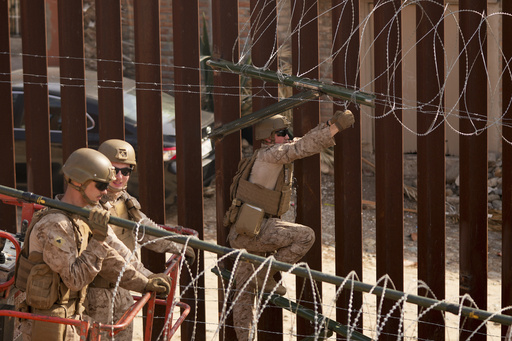SAN DIEGO — A group of Marines recently completed the task of laying down coils of concertina wire at the border wall separating Tijuana from San Diego. The operation was executed promptly and efficiently, taking place during a bustling weekend at the busiest border crossing between the United States and Mexico. The addition of the wire is expected to deter illegal crossings by making it more challenging for migrants to climb over the wall.
The role of military personnel in bolstering border security has been a practice since the administration of George W. Bush. President Donald Trump has signaled a strong interest in utilizing armed forces more extensively to address what he terms a “disastrous invasion” of migrants and drugs. Historically, the military’s involvement at the border has been limited to support functions, including surveillance of illegal crossings from both land and air, vehicle repairs, and infrastructure development, all while adhering to the Posse Comitatus Act of 1878, which restricts military involvement in civilian law enforcement.
During a recent visit to San Diego, it was observed that the military’s operations were consistent with their previous missions. Nevertheless, some experts and advisors close to Trump argue that there are legal justifications for deploying the military to tackle issues of narcotics trafficking and large-scale migration. Trump’s declaration of a national emergency at the southern border suggests he might redirect funds, akin to his first term strategy, to secure billions for constructing the border wall.
The initiatives outlined in his first-day orders introduce the possibility of using wartime powers such as the Insurrection Act of 1807, which would permit him to dispatch active-duty troops to quash perceived rebellions. Trump has assigned 90 days for Defense Secretary Pete Hegseth and Homeland Security Secretary Kristi Noem to provide their recommendations on these matters. Notably, Adam Isacson, who monitors military engagements at the Washington Office on Latin America, commented on the expansive reach of the Insurrection Act, stating that it allows the regular military to perform a variety of functions on domestic soil.
Trump’s approach diverges significantly from his predecessors. While the military has previously assisted with housing migrants, its current practice of organizing deportation flights to Guatemala, Ecuador, and Colombia marks a notable shift. Trump has also proposed utilizing a detention facility at Guantanamo Bay for housing tens of thousands of what he classifies as the “worst criminal aliens,” although implementation of this plan has yet to materialize.
There’s a growing sentiment among Border Patrol agents and others that more changes are forthcoming. Isacson believes that the administration may take cues from Texas Governor Greg Abbott’s “Operation Lone Star,” which empowered the state’s National Guard in border security operations. In the first week of Trump’s presidency, the Department of Defense deployed 1,600 active-duty troops to the border. Recently, U.S. officials indicated plans to send at least 1,000 additional troops in response to immigration concerns, with a split deployment of around half going to the border and half heading to Guantanamo Bay.
Currently, military visibility in San Diego remains minimal. The Marines positioned concertina wire at the base of the existing 18-foot-high border wall, creating an additional obstacle for migrants who may attempt to scale it. Those who successfully navigate the wire will then face an imposing 30-foot-high wall.
A recent aerial assessment via Osprey military transport aircraft highlighted Border Patrol vehicles stationed at strategic points along a stretch of approximately 70 miles from the Pacific Ocean into rugged ranchland and mountains east of San Diego, where migrant crossings are relatively rare. Border Patrol Chief Michael Banks reported that average arrests for illegal crossings had fallen to 654 per day over the last week, a notable decrease from a daily average of 1,527 in December. San Diego has remained a hotspot for illegal crossings over the past year, seeing a daily average of 222 arrests during the week ending January 25, which reflects a slight decline from the previous week’s figure of 237.




